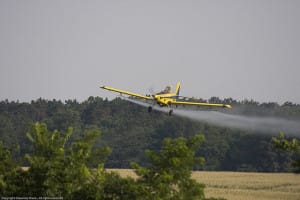The Community Word
by Clare Howard
 |
After 40 years of farming in rural Princeton, Dan Schafer is between a rock and a hard place, grappling with a problem that could threaten his livelihood and the safety of the public food supply.
He told his long-time buyer Tyson what happened to his registered Hereford beef cows, and the company refused to accept his meat.
Several people have told him to forget the story and send his meat to a packinghouse.
But Schafer refuses to forget the story.
He’s documenting what happened late one afternoon on a Thursday in July last year, and he’s observing a cascade of subsequent little disasters.
“I have grandkids. This is the first year of my life I’m not going to eat my own meat,” he said. “I’ve worked with Tyson for 20 years, and I now have 39 cattle ready to go to market and no one to sell them to.”
The source of Schafer’s problems is a spray drift incident. A neighbor, Carol Rodriguez, called last July to tell him she saw a crop duster spray his cattle and his hay field. He filed a pesticide drift complaint with the Illinois Department of Agriculture. An inspector examined the field three weeks later and despite the time lag still found evidence of Headline, a fungicide manufactured by BASF.
Several days later, the neighbor saw the fields around her house sprayed again. This time, she learned, it was Quilt Xcel, a fungicide manufactured by Syngenta.
BASF advised Schafer to store the hay in his Harvester silo and told him that after 21 days the chemical would ferment out, and he could safely feed the silage to his animals.
Schafer is convinced that didn’t work and the silage contaminated his herd. Four of six calves died shortly after birth. His herd is malnourished and “eating the barn” trying to find nutrients. The mineral supplement he’s always given his herd used to last for weeks and now it’s consumed in days. By mid July, the animals hadn’t shedded off their dead hair.
He was told that the fungicide probably killed the bacteria in his cows’ ruminant digestive system. After buying clean feed this spring, Schafer started to see his cattles’ health improve. However, a vet told him even if the animals appear to regain their health, he must tell any potential buyer about the pesticide exposure. Schafer estimates his loss could be $80,000 if he can’t market his animals.
“The pilot did this damage and what does the Department of Ag do? Send him a no-no letter. A little slap on the wrist,” Schafer said. “The punishment is greater for shooting a deer out of season.”
Rodriguez, a retired occupational health nurse and Schafer’s neighbor who witnessed the incident, said, “If I were to smoke in a restaurant, the punishment would be greater.”
She worked in respiratory health programs and is knowledgeable about airborne hazards.
“If this had happened in a factory, it would be an OSHA violation,” she said.
The Illinois Department of Agriculture warning letter was issued to R&R Flight Service. The company declined to provide an official comment, but a man who refused to give his name subsequently called Community Word and said the fungicide drift was found on grass, not alfalfa, and Schafer did not observe the incident. The caller doubted there was any connection between pesticide drift and Schafer’s dead and sick animals. He said the matter is with his insurance company.
Meanwhile, Schafer contacted the Illinois Attorney General’s office and was given the name and phone number for the Spray Drift Education Network, a grassroots organization helping people report and prevent pesticide drift. He spoke with Jane Heim, one of the co-founders of the network. She put him in touch with Farm-to-Consumer Legal Defense Fund.
Pete Kennedy, an attorney with the not-for-profit legal defense fund, said his organization is evaluating the case and considering whether to represent Schafer.
“Unfortunately, these overspray situations are way too common and farmers can’t afford to hire an attorney to litigate each time. That’s where we come in,” Kennedy said. “If we take on Dan’s case, it will be the third Illinois farmer we’ve represented” in the past three years.
He said this problem is occurring all over the country with increasing frequency.
“It doesn’t seem like the EPA is a lot of help with this problem,” Kennedy said, noting that spray drift is outside the main mission of Farm-to-Consumer but it’s too important to ignore. “We can’t have local food if we’re destroying it,” he said.
Linda Wells, organizer with Pesticide Action Network, said both Headline and Quilt Xcel can be problematic, but Quilt is a known reproductive toxin and possible explanation for the dead calves.
She is working with a coalition of farmers in Iowa on legislation that will increase training for pesticide applicators and increase the liability for applicators proven to be responsible for chemical drift problems.
“We live in such a toxic society, it’s hard to establish causality,” she said. “Our regulatory system needs drastic overhaul. The EPA needs independent science, not industry science” to evaluate chemical safety.
Constant heavy rain in central Illinois this summer has increased aerial applications of pesticides.
“With all the rain we’ve had this year, and now high humidity and heat index values up to 110, there is going to be a lot more pressure on farmers owning thousands and thousands of acres of corn and soybeans to spray fungicides and insecticides,” said Heim of the Spray Drift Education Network. ”The farmers’ spraying schedule is already behind due to the rains. With fields so wet, get ready to see lots more planes spraying dangerous pesticides into our air.”

